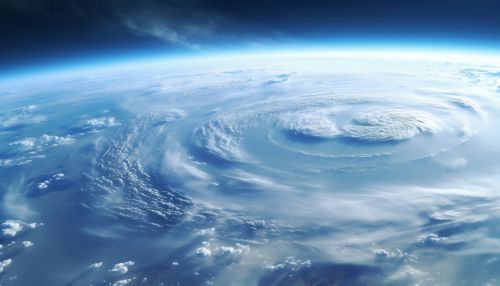The Science of Earths Atmosphere
Introduction
The Earth's atmosphere is a layer of gases, commonly known as air, that surrounds the planet Earth and is retained by Earth's gravity. The atmosphere of Earth protects life on Earth by creating pressure allowing for liquid water to exist on the Earth's surface, absorbing ultraviolet solar radiation, warming the surface through heat retention (greenhouse effect), and reducing temperature extremes between day and night (the diurnal temperature variation).
Composition and Structure
The Earth's atmosphere is composed of 78% nitrogen, 21% oxygen, 0.9% argon, and 0.03% carbon dioxide along with small amounts of other gases. There is also water vapor which varies from 0% to 4%. The remaining gases are often referred to as trace gases, among which are the greenhouse gases such as water vapor, carbon dioxide, methane, nitrous oxide, and ozone. Learn more about the chemistry of the atmosphere.


The atmosphere can be divided into five main layers. These are, from nearest to farthest from the Earth's surface: the troposphere, stratosphere, mesosphere, thermosphere, and exosphere. The exosphere, the outermost layer, extends from the top of the thermosphere to about 10,000 km (6,200 mi) above the Earth. Learn more about the layers of the atmosphere.
Physical and Chemical Properties
The physical properties of the Earth's atmosphere include temperature, pressure, and density. These properties change with altitude, and help define the various layers of the atmosphere. The chemical properties of the atmosphere include the concentrations of the different gases, and the reactions they undergo. For example, the ozone layer in the stratosphere is created by a reaction between oxygen molecules and ultraviolet light from the Sun. Learn more about the physics of the atmosphere.


Weather and Climate
The Earth's atmosphere plays a key role in the weather and climate of the planet. The movement of air in the atmosphere, driven by heat energy from the Sun, causes weather patterns. Over long periods of time, the average weather patterns in a region determine its climate. Learn more about weather and climate.


Impact on Life
The Earth's atmosphere has a significant impact on life on the planet. It provides oxygen for respiration, carbon dioxide for photosynthesis, and nitrogen for plant growth. It also protects life from harmful solar radiation and helps to regulate the planet's temperature. Learn more about the impact of the atmosphere on life.


Human Impact and Climate Change
Human activities have had a significant impact on the Earth's atmosphere. The burning of fossil fuels has led to an increase in the concentration of carbon dioxide, a greenhouse gas, which is causing the Earth's climate to warm. This is known as climate change. Other human activities, such as the release of chlorofluorocarbons (CFCs), have led to the depletion of the ozone layer in the stratosphere. Learn more about human impact and climate change.


